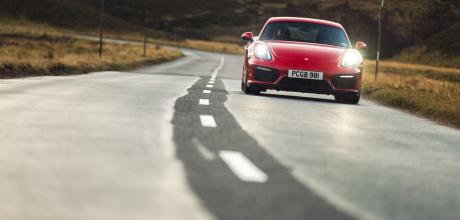Tech Buyers Guide Porsche Cayman GTS 981C

If a GT4 is too track oriented for your tastes, but a Cayman S is a little too soft, then the 981 Cayman GTS is the perfect in-between, combining huge comfort with a sharper chassis...
TECH: BUYING
Porsche Cayman GTS 981C
What to be aware of when on the hunt.
Words Robert Smith
Photography Chris Wallbank
By the time of the 981-generation Boxster/Cayman's arrival in 2012, Porsche's calculated merging of 911 and Boxster assembly lines as a means of radically cutting the cost of vehicle production (and, crucially, helping the company to return to financial stability) was less pronounced, allowing the 981 Boxster/Cayman twins to finally branch out on their own.

The Boxster and Cayman remained inextricably linked, of course — whenever one of the 981 twins was released as a special edition (Boxster Spyder, for example), the other was immediately ready to answer back (Cayman GT4). The Cayman GTS, launched in 2014, however, provided the mid-engined coupe with the right kind of appeal to attract a new audience of buyers who didn't want to engage in open-top motoring, but liked the idea of a nimble, mid-engined two-seater Porsche with enough attitude to make buyers of the Cayman S wonder if they'd made the right choice.
In truth, the GTS produces only a small amount of extra engine output over the S (335bhp versus 321bhp, with the dash to 60mph from rest taking just 0.3 seconds less in the Cayman S) and utilises the same 3.4-litre flat-six, but the exquisite styling and chassis package developed for the GTS makes it seem like a Porsche more closely associated with the 3.8-litre GT4.
The newly developed bumpers and lashings of Alcantara applied to the Cayman GTS were accompanied by the option of a passive sports suspension system in place of Porsche Active Suspension Management (PASM), introducing a drop in ride height of twenty millimetres over the base Cayman. The Sport Chrono package was standard equipment, as were twenty-inch Carrera S wheels and a new sports exhaust system. Porsche quoted a top speed of 177mph.
The approach the Stuttgart squad took in developing the 981 Cayman GTS resembled their thinking with development of the 987 Cayman S Sport (featured elsewhere in this magazine) and the celebrated 987 Cayman R, but where those models were produced in small numbers, the 981 Cayman GTS was the subject of much higher-volume production, making it available to many more Porsche enthusiasts.
At its original point of sale, the GTS would have set you back an extra £6,500 over the cost of a Cayman S, bringing spend to £55,397. Even taking the price of adding Porsche Ceramic Composite Brakes (PCCB) into consideration, the GTS was fantastic value for money. With prices now starting around £40k, the GTS represents an even better buy today. Acquire one without delay.
BODY
Even the oldest 981 has seen less than a decade on the road. Combined with modern automotive manufacturing techniques and anti-rust measures put into place by Porsche, this means finding body corrosion anywhere on a 981 is virtually unheard of. With this in mind, evidence of poor panel gaps, difference in shades of paint between sections of the car and, of course, any sign of body damage needs to be evaluated carefully — you might be looking at a Cayman which has been involved in an accident, a key consideration when thinking about buying a car previous owners may have been tempted to put through its paces at a track. As mentioned earlier, the 981 Cayman GTS was the subject of relatively high volume production, so don't be afraid to walk away if you sense something is amiss — there are plenty more Caymans of this ilk to choose from.
The 981 is still new enough for problems associated with high mileage or major wear not to have presented themselves. Much like the second-generation 997, rear lights can attract frustrating condensation, but don't let this put you off a well-priced GTS in the specification you desire. As a priority, however, make sure the car's extendable rear wing works as Porsche intended.
The 981 Cayman GTS features a black chin spoiler at the base of its redeveloped front bumper, paired with black air intakes sitting below bi-Xenon headlights. It's a similar story at the back of the car, where a black lower apron is joined by further black detailing, including the model's badges and smoked lamp lenses.
Don't be surprised to learn the car you're looking at is wearing a front bumper subjected to a respray. Naturally, you'll want to be sure the paint colour is a perfect match for the neighbouring panels, and you should be clear motivation for the work wasn't a shunt, but keep in mind many Porsches of this age will have been treated to a 'nose job' to eliminate unsightly stone chips accrued during spirited blasts along backroads. Verify a reputable bodyshop was charged with carrying out the work. If in doubt, ask an independent specialist to conduct a pre-purchase inspection. The upfront cost could save you a lot of money in the long run.
IDENTITY
981 Cayman or no, the easiest way to correctly verify the identity of the car you're looking at is to check its Vehicle Identification Number (VIN). Make sure it matches what’s printed on the V5. Elsewhere on the same document, you’ll see the car’s engine number. Make sure it checks out. Spend a tenner at mycarcheck.com, where you can download a history report outlining any insurance claims, change of registration number, recorded mileage and whether there is any outstanding finance on the GTS you're evaluating. You should also enter the vehicle’s details into the DVLA’s online MOT database (access it at bit.ly/dvlamot), a service which will return all passes, failures and advisories registered as far back as records are stored. You can also take advantage of the Suncoast Parts VIN decoder (check it out at bit.ly/suncoastvin), which will provide you with a Porsche-specific build sheet for just $10. This document will let you know exactly how the car left the factory, including model specification and any Individual Equipment items optioned. We've lost track of the number of Porsche owners who have discovered their car makes use of a special feature they only found out about after ordering this report, though your local Porsche Centre or the car's original dealer may be able to furnish you with the same information without charge.
ENGINE
The 981's 3.4-litre flat-six is an excellent engine, producing 335bhp and 280lb-ft in GTS guise, compared with 321bhp and 273lb-ft for the 981 Cayman S.
That said, cam timing solenoid valves can be problematic. There are two on each bank and we recommend replacing them in pairs on a single side, even if only one is at fault. There is no need to replace all four parts unless your 981 registers a problem on each bank, which is unlikely. If you do find yourself faced with the need to replace all four items, budget three hours labour in addition to the cost of parts.
Routine servicing must be observed every 20k miles or at least once a year, even if the car hasn't covered much ground. Service history from Porsche dealerships or independent marque specialists is something you should place at the top of your 981 Cayman GTS wish list.
Get on all fours and check beneath the car for fluid leaks. Also, make sure you conduct a test drive before agreeing to pay for the GTS you're looking at. It's imperative you're confident you're not buying a Porsche ragged by previous owners. There's less chance of damage with PDK-equipped cars, where over-revving is virtually impossible, but it pays to experience the feel, sound and performance of a car's engine before committing to purchase.
Porsche Club Great Britain recommends connecting any modern Porsche to factory-linked Porsche Integrated Workshop Information System (PIWIS) diagnostic equipment in order to check for stored fault codes and to compare the digital motor electronics (DME) system's registered mileage with what's displayed on the dashboard, which some unscrupulous dealers may have altered.
Considering the GTS is less than a decade old, you shouldn't need to worry about replacing the exhaust or any major engine components. Check to see if an aftermarket system is in place.
BRAKES, SUSPENSION AND TRANSMISSION
The GTS was offered with a six-speed manual gearbox or a seven-speed PDK semi-automatic dual clutch transmission (as per the example on these pages). It's of paramount importance the PDK system is treated to fresh lubricant at Porsche's recommended service intervals (every six years). Check the book pack and service history of the PDK-equipped car you're looking at to ensure this maintenance has been observed. PDK was a £1,900 option, so expect to pay a premium for cars loaded with the system. Clutches should last at least 60k miles before they need to be replaced, costing upwards of £1,000.
There isn't anything untoward to report as far as 981 braking equipment is concerned, other than to point out Porsche Ceramic Composite Brakes (PCCB) were a £4,977 option for the GTS. While you might think this is a kit worth holding out for, be aware of the cost of replacing this system's consumables — even aftermarket replacement discs will set you back thousands. PCCB might seem attractive, but if you're looking at a GTS with these awesome anchors in place, carry out a visual inspection of the discs and pads to determine how much life is left in them — you don't want to be saddled with big spend early into your GTS ownership experience. If you suspect replacements are on the cards, factor the cost into the amount you're prepared to pay for the car.
The GTS is loaded with Porsche Active Suspension Management (PASM) dampers as standard. As mentioned earlier, however, passive sports suspension was a cost option, dropping ride height by twenty millimetres. If you're planning to drive your GTS hard, we'd recommend looking for an example with the sport suspension package, which, combined with good quality tyres and skill behind the wheel, will light up any journey, the result of better-weighted steering, firmer springs, a lower centre of gravity and more direct feedback. Sport Chrono is standard and, in Sport Plus mode, will introduce auto-blip rev matching on manual downshifts. Dynamic gearbox mounts are also at play.
INTERIOR & ELECTRICS
The materials Porsche used for 981 interiors are incredibly robust, but be mindful of possible driver's seat bolster wear, The only real complaint we've come across is weak switchgear. More specifically, the electric window switches, door mirror switches and heater control switches become brittle and can snap. The electrics themselves cause no problems, though dash warning lights suggesting otherwise can be triggered by a battery running low voltage.
Needless to say, it's a good idea to keep your 981 connected to a trickle charger, avoiding low battery voltage during rest. Elsewhere, scuttle drains can get blocked over time, especially on a 981 left standing outside for long periods. It's essential these are regularly cleaned, else rainwater will flood the scuttle pan and litres of water will seep behind the dashboard, playing havoc with some of the 981's electrical systems. If fitted, the Porsche Vehicle Tracking System (VTS) is particularly susceptible to error, causing alerts to be sent to Vodafone, the company responsible for monitoring the whereabouts and safety of the car.
We love the 981 Cayman GTS and can't think of a single reason why you shouldn't buy one. Our only criticism is the in-car infotainment system user interface and display, which looks very dated, though it's worth remembering the 981 platform was first introduced in 2012. A replacement aftermarket head unit boasting smartphone connectivity and integration with all your favourite apps is a wise move. There are many available systems to choose from.

